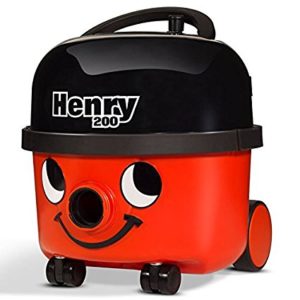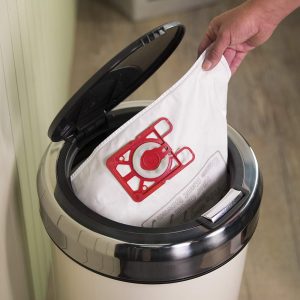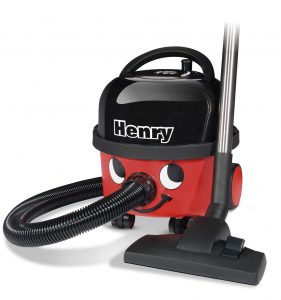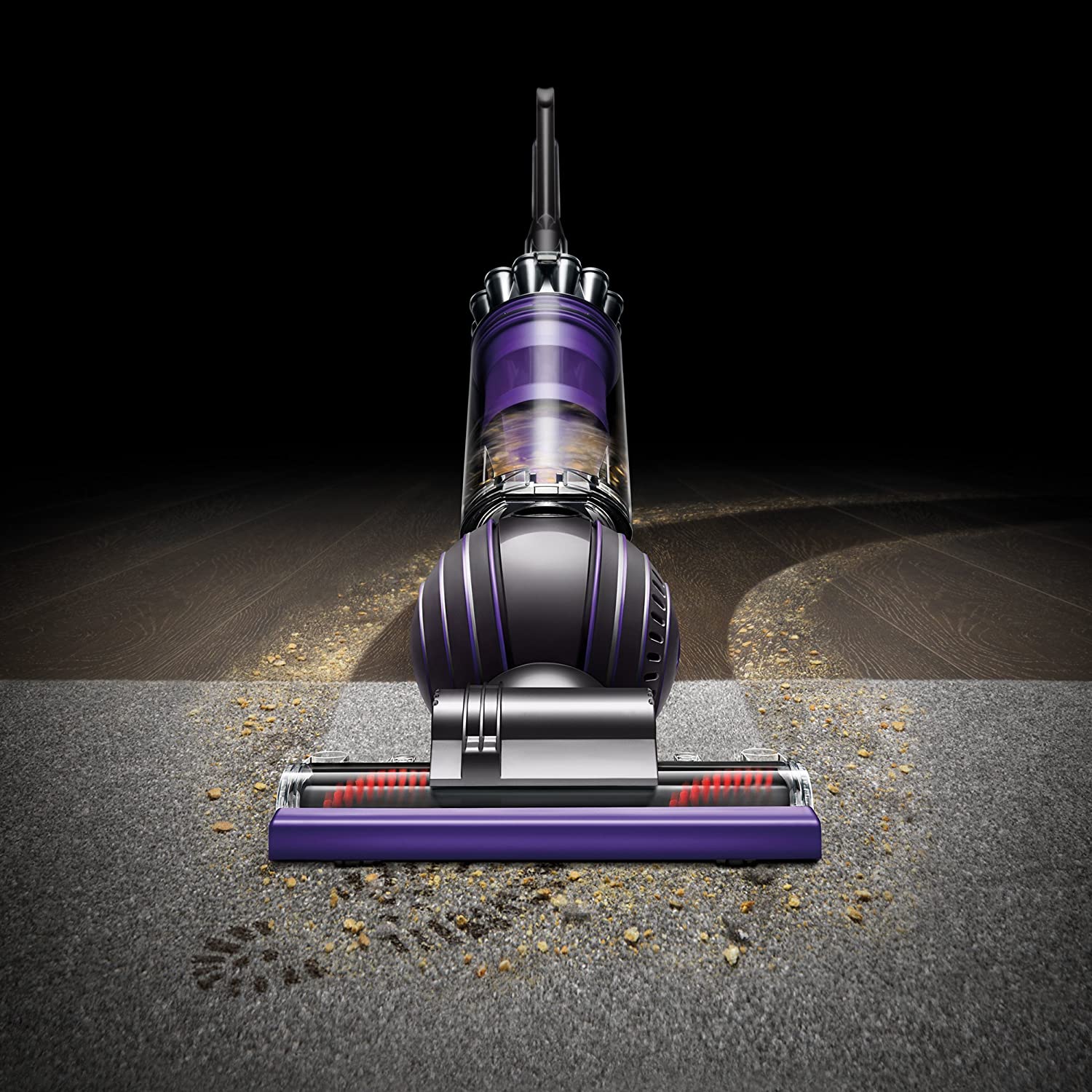Henry Hoover review
Famous for his red colour and smiling face, the Henry Hoover has been a mainstay in UK households and workplaces ever since it first arrived back in 1981, nearly 40 years ago. Produced by British manufacturer Numatic, the Henry has become a hugely popular vacuum cleaner, and its popularity shows no signs of slowing down.
Henry is a bagged cylinder vacuum that comes complete with strong suction power and a large dust bag capacity, making him an ideal household vacuum. His iconic appearance helps him to stand out, but Henry also continues to deliver when it comes to cleaning performance.
So that he can continue to deliver as a vacuum, Henry has had a number of iterations over the years as Numatic have made tweaks to ensure he remains very good at what he does best. The latest model of Henry is the HVR160, which replaced the larger Henry HVR200. Both remain available for purchase from major UK retailers, so this Henry Hoover review will detail both the Henry HVR160 and Henry HVR200 models and how they compare to each other.
PROS
- Powerful and energy efficient suction
- Large dust bag capacity with strong Hepa Flo bags
- Long cord and hose
- Range of cleaning tools and attachment
CONS
- Fairly bulky and therefore not the easiest to move around or store
- Better vacuums available for cleaning stairs
Henry Hoover Specs (160-11 model first / 200-11 model second)
| Brand | Numatic |
| Colour | Red / Black |
| Weight | 7.5 Kg / 8 Kg |
| Capacity | 6 litres / 9 litres |
| Power | 620 watts / 580 watts |
Before we go into detail on Henry, If you’d like to know more about Henry’s family you can check out our post on the Henry Hoover range. Other Henry range reviews you may find useful:
Henry Hoover wattage
There have been a number of iterations to Henry over the last decade in terms of motor power, meaning the Henry Hoover suction power and wattage is different depending on which model you have at your disposal.
your disposal.
Both the Henry HVR 160 and HVR 200 models have seen a large reduction in motor power when compared to previous versions of Henry. In September 2014 the EU imposed a limit on vacuum cleaners limiting the wattage to 1600W, and by 2017 that limit went down even further to 900W. The previous Henry Hoover wattage at 1200W was above the new limit set in 2017, so Numatic made big changes and reduced the Henry 160 model to 620W, nearly halving Henry’s previous wattage. The Henry 200 model at 580W has gone one step further, but this shouldn’t be seen as a negative.
Numerous changes have been made by Numatic to increase Henry’s efficiency, meaning despite the reduced wattage the Henry Hoover power is just as powerful – if not more powerful – than previous versions. Henry also now makes a lot less noise with the low wattage motor much quieter than standard vacuums, and as an added bonus the latest Henry models will also use around half the electricity compared to older versions.
Previous versions of Henry came with two settings for suction power, operated by a high and low switch. The high option operated at 1200 watts and the low option at 620 watts, meaning you could almost double the suction power when needed. The latest Henry models do not come with the same setting so it’s no longer a case of Henry Hoover 1200w vs 620w,, there is just the one vacuum mode which operates at 620 watts with the 160-11 model and 580 watts with the 200-11 model.
What is the difference between Henry 160 and 200?
There is a notable difference when comparing Henry 160 vs 200 in terms of bag capacity. The HVR200 model provides a huge nine litre capacity in comparison to the six litres you get with the HVR160. Even at 6 litres the Henry 160 offers more than five times the capacity of many bagless vacuums, but at 9 litres the Henry 200 model is in a different league. Either way, both the HVR160 and HVR200 offer large capacities, but if you want as much capacity as possible then the HVR200 model should appeal. The benefit of a larger capacity means emptying less often and using less bags, but as above both of these models offer a large capacity.
In general, you tend to see the HVR200 model used by professional cleaners in the likes of offices, hotels and large retail spaces where the extra capacity comes in handy, and the HVR160 is usually the one used in households.
In addition to bag capacity, there is a difference in suction power as detailed above, though it’s only a small difference of 40 watts so it’s unlikely something that you’ll notice.
Despite the difference in capacity and suction power, there isn’t much difference when it comes to price. Both models can normally be purchased for less than £150, making them affordable vacuums. Whilst you’ll generally pay slightly more for the HVR200 model, at the time of writing the difference is less than £5.
Henry Hoover: HepaFlo dust bags
 A new Henry vacuum will come with a fitted bag ready to be used and also come with two spare bags. The HVR160 and HVR200 models use Numatic’s HepaFlo bags, which have been specifically designed for Henry machines. The bags have been built to maximise capacity and ariflow, helping to deliver peak suction.
A new Henry vacuum will come with a fitted bag ready to be used and also come with two spare bags. The HVR160 and HVR200 models use Numatic’s HepaFlo bags, which have been specifically designed for Henry machines. The bags have been built to maximise capacity and ariflow, helping to deliver peak suction.
The HepaFlo bags use three layers of material to increase filtration and have self-seal tabs which lock all the dust and debris within the bag itself. This stops the dust escaping out into the surrounding environment and helps to prevent allergies spreading around the home. The bags are extra large and super strong and on average need to be replaced only every four months or so. Replacement bags can be purchased cheaply from major retailers.
A common question that Numatic gets is can Henry Hoover be used without a bag? Numatic advise not to use the Henry Hoover without bags. Over time if you do use the Henry without bags, you risk damaging the motor which could lead to reduced performance.
Changing the dust bag themselves is not difficult. To access the dust bag you remove the two clips either side of Henry’s motor unit, lift the motor unit off, and under the filter you’ll find the large dust bag.
Henry Hoover: Weight & design
 Both the HVR160 and HVR200 models have a similar weight, though it isn’t exactly the same. With a larger capacity comes with a little extra weight, so the Henry 200-11 weighs in at 8.1 kg, whereas the Henry 160 is a bit lighter at 7.5 kg.
Both the HVR160 and HVR200 models have a similar weight, though it isn’t exactly the same. With a larger capacity comes with a little extra weight, so the Henry 200-11 weighs in at 8.1 kg, whereas the Henry 160 is a bit lighter at 7.5 kg.
At either 8.1kg or 7.5kg, Henry is not the lightest cylinder vacuum available on the market. This means his effectiveness at cleaning stairs is not as good as some other vacuums, and he isn’t the easiest vacuum to move around the home. However, Henry does come with a series of adaptors and nozzles that give you flexibility to reach surfaces some distance from Henry’s frame.
And an advantage of the latest Henry models is the extra long 10m cable. The 10m cable stores neatly inside the machine, allowing you to clean large areas without constantly switching plug sockets. 10m should allow you to clean the whole downstairs or upstairs of an average-sized home, and it also means you can leave Henry at the bottom of a flight of stairs when cleaning a staircase. When you’re finished cleaning with Henry, there is a cable reel on top of the hoover which you need to wind around manually to store the cable in Henry. Henry also comes complete with a built-in carry handle which is ideal for when lifting Henry to your car or up the stairs, or even between rooms.
There is also a parking bracket on the side of Henry which can be slotted into place when pausing your vacuuming. You can also store one of the cleaning tools – recommended to choose the one you use the most – directly on your Henry allowing for quick access when switching to one of the other cleaning tools.
The Henry Hoover hose is very long at 2.4m. This is the one of the big changes Numatic have made to the latest Henry’s to increase efficiency. The hose is conical, meaning it’s wider at the vacuum end than it is at the handle end. This helps to increase airflow and vastly increase performance, despite the newer Henry’s having significantly less wattage than its previous versions.
Henry Hoover: Perfect for carpets and hard floors
Henry Hoover is a great all-rounder and can be used to clean both carpets and hard floors, and you can easily switch between the two thanks to Henry’s combi floor tool, where brushes are positioned down when cleaning hard floors and up when cleaning carpets.
Due to the design of the floor head and his powerful suction, Henry is especially good at cleaning carpets. Henry will pick up dust and debris from carpets with no problems at all, and though there are better specialist pet vacuums on the market, he’s pretty good at picking up pet hair, too.
Henry is also more than adequate when cleaning hard floor surfaces such as laminate. His powerful suction means dirt and stains from hard floors can be tackled with ease, with the brush head designed to pick up all debris it finds.
Henry is also a great vacuum to use when cleaning your car. With a range of different tools for the job, Henry can be used to clean the dirt near the pedals, as well as picking up pet hair if your animals sometimes travel with you. With a long hose and 10m cable cleaning a car is not a problem for Henry.
What attachments come with Henry Hoover?
As well as Henry himself and the combi floor tool mentioned above, there are a range of attachments that come in the Henry Hoover box. There are also a range of small cleaning tools, including:
- A slim crevice tool for nooks and crannies
- A soft dusting brush for shelving / delicate items
- An all-purpose nozzle that has a slide-on brush
The nozzle is especially good for stairs and car seats. You also have the option of sliding the brush off if you want to do your upholstery which is a little more delicate.
In addition Henry comes complete with an adaptor which can be used to attach any of the cleaning tools to the end of the hose. This is ideal for when cleaning in a confined space such as a car.
Henry also comes with two extension tubes and a carpet and floor nozzle. The carpet and floor nozzle is one of the main changes with this new version of Henry. It’s completely different to earlier versions of Henry and does feel like an improvement, allowing for an all-round better clean. Unlike the old Henry it doesn’t have the metal base plate. It’s a plastic base plate with litter pickers either side of the suction inlet which help deal with more clinging litter such as pet hairs. There is also a foot operated switch that lowers the brush all the way around for cleaning hard floors.
Henry Hoover FAQs
How long should a Henry Hoover last?
Henry Hoovers are well known for being built to last. Numatic has made over 10 million Henry’s over the years, many of which are still in use today. Independently rated as the UK’s most reliable vacuum brand, a Henry Hoover should last for many years and comes with a two year warranty in case anything breaks in those first two years.
What’s so good about a Henry Hoover?
Henry Hoovers are so popular because of their reliability and affordability. Manufacturer Numatic has been making Henry’s since 1981, and to this day you know with a Henry you’ll get reliable performance and a very capable vacuum cleaner. Henry is also an affordable vacuum cleaner, often priced at cheaper than most comparable vacuums on the market.
Why do professional cleaners use Henry?
Henry Hoovers are popular with professional cleaners because of their large capacities, reliable performance and versatility across different floor types. Millions of Henry Hoovers are used by professional cleaners across the UK.
Can you use a Henry Hoover on wet carpet?
A regular Henry Hoover should not be used to clean up wet surfaces and spills. There are other hoovers from the Henry range – such as George Hoover and Charles Hoover – that have been designed to deal with wet surfaces, but Henry is not one of them.
Is Henry as good as Dyson?
It’s difficult to answer which is better when it comes to Henry vs Dyson, as it comes down to personal preference. One key difference is that Dyson vacuums are all cordless, whereas nearly all Henry vacuums are corded. With Dyson you’ll be getting a more modern and slick design, but with Henry you know you’re getting a very reliable hoover. Dyson’s will generally cost a lot more than a Henry Hoover, so there’s a number of things to consider when weighing up which is better.
What’s the difference between red and blue Henry?
Whilst the traditional Henry comes in red, you can get Henry in a variety of colours including blue, green and yellow. Other than the colour, there is no difference between the vacuums, they offer exactly the same in terms of performance.
Henry Hoover Pros
- Powerful and energy efficient suction
- Large dust bag capacity with strong Hepa Flo bags
- Long cord and hose
- Range of cleaning tools and attachment
Henry Hoover Cons
- Fairly bulky and therefore not the easiest to move around or store
- Better vacuums available for cleaning stairs
Henry Hoover review: Verdict
Numatic have been making Henry Hoovers for decades and it really tells with the Henry HVR160 and HVR200 – you’ll struggle to get a more reputable brand in the UK vacuum market. Whilst Henry’s main cons are his weight and effectiveness at cleaning stairs, he has many positive features that out-weight the negatives.
Henry is a super cylinder vacuum and is a real bargain at his price point. The efficiency changes made by Numatic mean they’ve somehow made Henry even better with the latest models, despite cutting his power by more than half. A large bag capacity and range of cleaning tools helps to make Henry stand out in the market.
There’s a reason that the Henry Hoover continues to be one of the most popular vacuum cleaners going, and it comes at great value when compared to other hoovers on the market. Hopefully this Henry Hoover review has helped to answer if Henry Hoover’s are good and worth buying – we certainly think they are.




